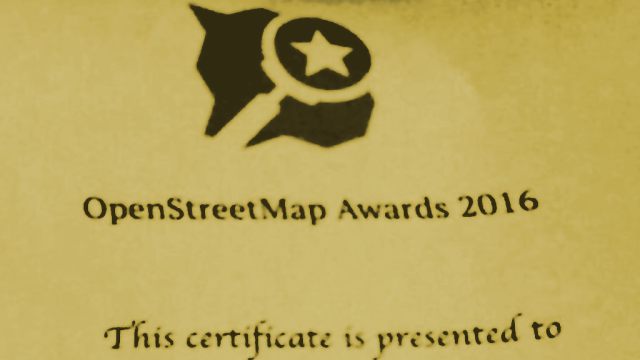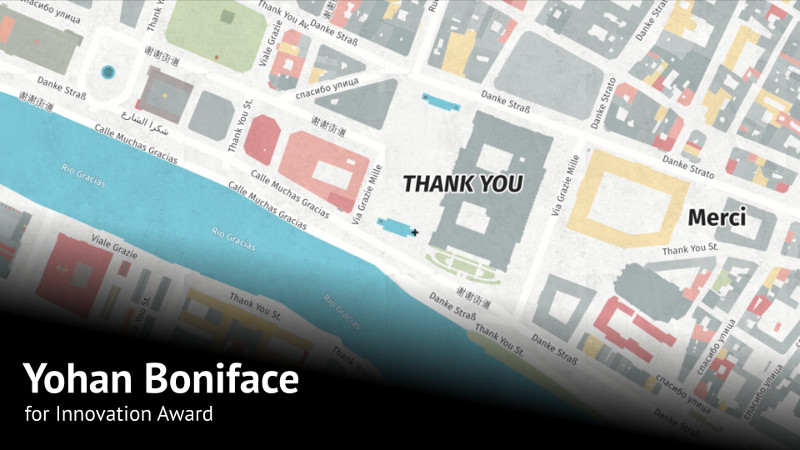 The community voting for the OpenStreetMap Awards 2017 is open! During the call for nominees you submitted more than a hundred of them. Then a number of active community members have prepared a shorter list. Now it is again your turn: choose who gets an award at the ceremony at the State of the Map in Japan.
The community voting for the OpenStreetMap Awards 2017 is open! During the call for nominees you submitted more than a hundred of them. Then a number of active community members have prepared a shorter list. Now it is again your turn: choose who gets an award at the ceremony at the State of the Map in Japan.
This time you would need to consider 45 nominees in 9 categories. That is a tiny fraction of active community members who did good in the past year, but still a lot to choose from. To make your task simpler, we have made a couple of changes.
You don’t have to select only one nominee for a category: that was a hard choice last year, and most of the time you’d wish you had more votes. Now you have! Choose as many as you like, even all of them. This process is called Approval Voting: studies show it is much fairer that the regular one-vote voting, and much easier to understand than STV. The winner is still determined by the number of votes.
And do use the fact that you can change or add to your votes at any time until the voting ends (that would be on 16th of August). We will cover all nominees in this blog, so you could make an informed choice. Starting right now, with the two technical categories. Nominees are listed in a random order.
Core Systems Award
For outstanding contributions to any of the core tools, systems, processes or resources. Not limited to systems under OSMF control. The Rails port, mapnik, and any other tool that mappers use on a daily basis, knowingly or not, are eligible.
- Hartmut Holzgraefe: the old MapOSMatic service for printing atlases went offline, but Hartmut set up the fork last year. And he did not stop at that: every week he is improving it in different ways. He has the biggest collection of map styles ready for printing. He added email notifications and fixed UI issues. You can even add your data on top of the map.
- Bryan Housel: you know iD, our amazing web-based editor. Bryan is supervising its development. Recently he has added a tutorial to it, and it is years ahead of what other OSM software offer. That tutorial even has an entire imaginary town to play with!
- Andy Allan: he has been improving OSM in small ways long before, but just a month ago Andy joined the website maintainers team and immediately started working on improving the code. And before that he upgraded all the tests for the website: important, but not very fun work, we guess.
- Kevin Bullock: as an employee of DigitalGlobe, he has been always asked at State of the Map conferences about new satellite imagery for OpenStreetMap. This Spring, due to his efforts, we finally got two new imagery layers. You must have already seen them in your editor of choice.
- Paul Norman and Matthijs Melissen: for more than half a year these two had been working on a major refactoring of our map style, the one you’ve liked even after roads changed their colours. Now all the rendering databases were reloaded, and style designers can finally use any tags they like: surface, covered, public_transport, you name it.
Innovation Award
For the best new service or approach. New tools for contributing data, image recognition, trace or OSM data analysis, new mapping approach or new perspective on old tools.
- Michael Straßburger: do “telnet mapscii.me” in a console, and you will see a map of the whole world, rendered with letters and punctuation. MapSCII is a brilliant example of all our map rendering technologies at work: vector tiles from the last year winner OSM2VectorTiles, mapbox GL styles, vector transformations. While visually simple, it proves we can do anything with our map.
- Yuri Astrakhan: people have long used SPARQL queries with Wikidata, and Yuri’s service links that with the spatial OSM database using 750 thousand “wikidata” keys we have. Now you can query for cities more than 2000 years old or get first ascension time for mountain peaks and get OSM identifiers for these.
- OpenTopoMap maintainers: made by Stefan, Philipp and Martin, OpenTopoMap renders the whole world in a topographic style falimiar to tourists and hikers. It also provides weekly updated Garmin extracts, so you don’t have to buy paper maps for a trip.
- Tobias Zwick: he is the author of the StreetComplete android map editor. Announced just in March, it has taken mappers by the storm, with half a million edits made by 5000 users. The app makes it very easy to map important properties of roads and amenities. Tobias constantly improves the app and listens to the comments on mailing lists and on GitHub.
- Sajjad Anwar: visualizing changesets is one of the hardest problems in OpenStreetMap. Most of us has been using Achavi, but it is slow due to the nature of requests to Overpass API. Sajjad removed the need for querying by creating a cache of all recent changesets, so visualizing takes less than a second. His work is already used by the OSMCha, a validation tool, and could possibly be integrated into the OSM website.
Now that you know what these ten nominees did, head to the OSM Awards website and click on these you think should get an award for their work. We’ll return next week to look at writing and mapping categories.
Photo of the certificate © Blog Conhecer OpenStreetMap


Pingback: Choose the best bloggers and mappers for the OSM Awards 2017 | OpenStreetMap Blog
Pingback: weeklyOSM 366 | weekly – semanario – hebdo – săptămânal – haftalık – 週刊 – týdeník – edisi
Pingback: weeklyOSM 367 | weekly – semanario – hebdo – săptămânal – haftalık – 週刊 – týdeník – edisi
Pingback: OpenStreetMap Awards 2017 – GeoNe.ws